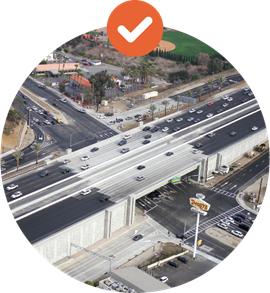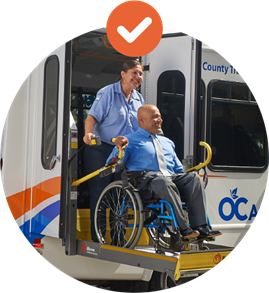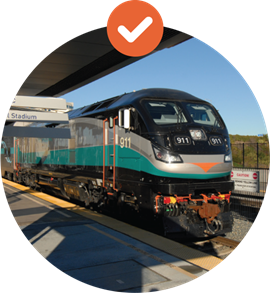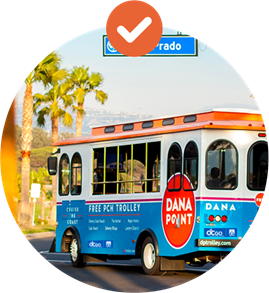2018 Highlights

FREEWAYS THAT MOVE YOU
Completed two freeway project segments, continued construction on the I-405 Improvement Project, and moved forward on two others.
The OC Go freeway program includes 27 project segments that will remedy traffic chokepoints and relieve congestion on Orange County freeways. To date, 12 freeway segments have been completed.
I-5 South County Improvements
As part of a three-part project to help relieve congestion through the cities of San Clemente, Dana Point, and San Juan Capistrano, six miles of carpool lanes in each direction were added to I-5 between San Juan Creek Road and Avenida Pico and the Avenida Pico interchange was reconstructed. The added carpool lanes opened to traffic in March 2018. Construction on the remaining two segments (Avenida Pico to Avenida Vista Hermosa and PCH to San Juan Creek Road) was completed in mid-2018. In total, the $230 million project required widening several bridges, realigning on- and off-ramps, and paving nearly 12 miles of new lanes.
Learn more.
I-405 Improvement Project
This project will improve 16 miles of the I‐405 in both directions through the cities of Costa Mesa, Fountain Valley, Garden Grove, Huntington Beach, Los Alamitos, Seal Beach, and Westminster.
In 2018, OCTA awarded the design-build contract to OC 405 Partners. Design-build is a project delivery method that allows design work and construction to occur simultaneously. One contractor is hired to perform both functions, which saves money and increases the speed that a project can be delivered.
With the contractor on board, OCTA began replacing and reconstructing five of the 18 bridges that line the project corridor. Additional improvements will include the addition of one general purpose lane, a second HOV lane to be combined with the existing HOV lane to provide a dual express lane facility, and improved local interchanges along the corridor between SR-73 to I-605.
The general purpose lane portion of the project is funded by OC Go with a combination of local, state and federal funds. The express lanes are separately funded and will be paid for by those who choose to pay a toll and use the 405 Express Lanes.
The project is anticipated to be complete in 2023.
Learn more.
I-5 (SR-73 to El Toro Road)
In partnership with Caltrans, OCTA continued work on the final design of a project that will widen I-5 from SR-73 to El Toro Road. This project has three segments and construction is expected to begin in 2019 on the middle segment (Oso Parkway to Alicia Parkway, including La Paz Road Interchange).
Learn more
I-5 (SR-55 and SR-57)
In partnership with Caltrans, OCTA will add a second high occupancy vehicle lane in both directions along I-5 between SR-55 and SR-57. Construction activities have begun and the project is anticipated to be complete in 2021.
Learn more

BETTER LOCAL STREETS
Allocated nearly $88 million for street improvements in 2018.
Every trip begins with a local street or road. Keeping them in good shape is an important component of OC Go.
OCTA approved $32 million for 11 projects as part of the Regional Capacity Program, which funds intersection improvements and other street improvement projects to help reduce congestion. In addition, $55.9 million in OC Go Local Fair Share funds were distributed to cities and the County of Orange to preserve existing streets and roads and to provide other transportation improvements based on the priorities and infrastructure needs of local cities.
Learn more.

GROUNDBREAKING STREETCAR
Began construction after receiving a $149 million federal grant for Orange County’s first modern streetcar.
This new public transit option is designed to move residents, employees, and visitors through the heart of the county and will be the first modern streetcar in California. The OC Streetcar will connect the Santa Ana Regional Transportation Center with activity and employment centers in Santa Ana.
The OC Streetcar will start at the Santa Ana Regional Transportation Center and serve Santa Ana’s historic downtown and Civic Center on the 4.5-mile route to Garden Grove. OC Streetcar will connect directly with 18 OCTA bus routes, including seven of the busiest routes in the county. In addition, the OC Streetcar is expected to support economic development and create jobs. Slightly more than half (59 %) of the funding comes from a mix of federal and state sources. The remainder comes from OC Go. Ridership projections estimate the OC Streetcar will carry more than 7,000 riders each day.
The project will require the construction of trackwork, bridges, and a maintenance and storage facility.
Learn more.

MORE GO, LESS STOP TRAFFIC LIGHTS
Approved six projects that synchronize lights in adjacent cities to help drivers travel more efficiently.
Driving through multiple cities stopping at red lights is difficult and time consuming. OC Go helps synchronize traffic lights across the county to improve the quality of your drive. To date, OCTA has synchronized more than 2,000 signalized intersections.
OCTA approved $8.9 million for six synchronization projects designed to reduce travel times, stops and delays, and emissions along Orangethorpe Avenue, Katella Avenue/Villa Park/Santiago Canyon, Main Street, Los Alisos Boulevard, Culver Drive/Bonita Canyon/Ford, and Garden Grove Boulevard. Additionally, OCTA leveraged approximately $900,000 in past project savings to secure $6.5 million in Senate Bill 1 Local Partnership Program funds.
In 2018, OCTA implemented 12 projects* that synchronized 348 signals along 84.1 miles. The corridors include Artesia Boulevard, Ball Road, Bake Parkway, Birch Street/Rose Drive, Bristol Street, Chapman Avenue, El Toro Road (west of I-5), Harbor Boulevard (Anaheim), Harbor Boulevard (Santa Ana), Moulton Parkway, Newport Boulevard (South), and Seal Beach/Los Alamitos Boulevard.
There are 29 projects planned or in progress through the Regional Traffic Signal Synchronization Program. To date, the program has resulted in:
- Implementation of 74 unique traffic signal synchronization corridor projects
- $98 million in funding awarded by the OCTA Board of Directors
Nearly 60% ($57 million) of the funding has been spent for updated Intelligent Transportation Systems (ITS) infrastructure, interconnecting 2,557 signalized intersections along 655 miles of roadway. This infrastructure provides the mechanism for coordinating the traffic signal systems and the communications pathways needed for future data sharing and connections.
Because of the new synchronized timing, people stopped less at red lights and proceeded through more green lights. Over the course of all projects, the average travel time savings was 13%. This resulted from an average speed increase of 2 to 5 miles per hour combined with an overall stop reduction of 30%. Because they experienced less stop-and-go traffic, Orange County drivers saved money on gas and reduced emissions and greenhouse gases.
*Since the last update to the Board, five projects have been implemented. The completed projects will be reported to the Board later this year after staff receives final reports and project costs.

INCLUSIVE MOBILITY
OC Go provided nearly $10.6 million in discounted fares for 13.6 million transit trips for seniors and persons with disabilities.
Three programs work together to provide efficient, cost-effective transportation for seniors and persons with disabilities.
The Senior Mobility Program fills the gap between local fixed-route buses and ACCESS service by providing transportation services to seniors in 31 cities in Orange County. OCTA and the participating cities contribute to the program. Another program supplements existing countywide senior non-emergency medical transportation services. The third program reduces fares for bus and ACCESS paratransit rides for seniors and persons with disabilities.

TRAFFIC-FREE TRAIN TRAVEL
There were nearly 5.1 million car-free boardings on the three Metrolink train lines serving Orange County.
Each day, commuters and other travelers use convenient Metrolink trains to get to work or other destinations within Orange County or the adjoining counties of Los Angeles, Riverside, San Bernardino, and San Diego.
Orange County has 12 Metrolink stations served by three lines – Orange County (OC) Line, Inland Empire Orange County (IEOC) Line, and 91/Perris Valley (91/PV) Line. Each weekday, commuters can choose from 27 roundtrip trains.
OC Go provides funding for rail line and station improvements. Current activities include replacing a bridge at San Juan Creek and adding new track adjacent to the existing mainline track from Laguna Niguel to San Juan Capistrano.
Opened in 2019 and partially funded by OC Go, the new five-story, 611-space Metrolink Parking Structure at the Orange Transportation Center in Old Towne Orange provides much-needed parking for transit users, shoppers, and diners.

CLEANER WATERWAYS
Awarded nearly $2.5 million to 12 local agencies this past year to improve water quality.
The Environmental Cleanup Program (ECP) uses OC Go funds for local projects that clean transportation-related pollutants from Orange County’s waterways.
In 2018, a total of $2.46 million was allocated to 12 local agencies to improve water quality. Since 2011, approximately $50 million has been awarded to 188 projects from all 34 cities and the county. The ECP portion of OC Go is forecasted to be $259.4 million over the 30-year period (2011 through 2041).
Learn more.

FOREVER PROTECTED
Completed plans that protect, preserve, and manage natural resources within all of OCTA’s seven open space preserves.
In exchange for expedited freeway projects, OCTA preserves and restores natural habitats.
A total of 1,300 acres has been permanently protected to enhance wildlife connectivity, safeguard sensitive species, and preserve substantial parcels of valuable habitat. Preserves are located in Brea, Laguna Beach, Silverado Canyon, and Trabuco Canyon. In addition, OC Go has funded 12 restoration projects that help remove invasive plants and restore approximately 350 acres of open space lands to their native habitat.
In 2018, OCTA finalized the remaining two plans that will guide the management of valuable wildlife and habitat on OCTA's Eagle Ridge Preserve in Brea and the Pacific Horizon Preserve in Laguna Beach. View all seven plans here.
These documents are a result of years of assessment and collaboration with the United States Fish and Wildlife Service and the California Department of Fish and Wildlife and will be reviewed every five years and updated as necessary.
Furthermore, in 2018 staff began work with a consultant to draft fire management plans for the seven Preserves. These plans will provide guidelines for decision-making at all stages including fire prevention, pre-fire vegetation management, suppression activities, and post-fire responses that are compatible with conservation and stewardship responsibilities. The fire management plans are anticipated to be complete in 2020.
Learn more.

CAR-FREE, CAREFREE COMMUNITY SHUTTLES
Funded 15 free and low-cost trolley/shuttles to beach towns and other areas to ease traffic and pollution.
In areas where regional transit doesn’t meet local needs, community shuttles that complement bus and rail service help provide solutions.
Ridership is monitored to ensure that performance standards are met.
Five new trolley expansion projects totaling $5.2 million were approved in 2018.
Free summer shuttles were offered in Laguna Beach, Huntington Beach, Newport Beach, San Clemente, San Juan Capistrano, and Dana Point. Shuttles often connect with each another and to transit and Metrolink stops, making it easier to travel to great destinations without a car.
